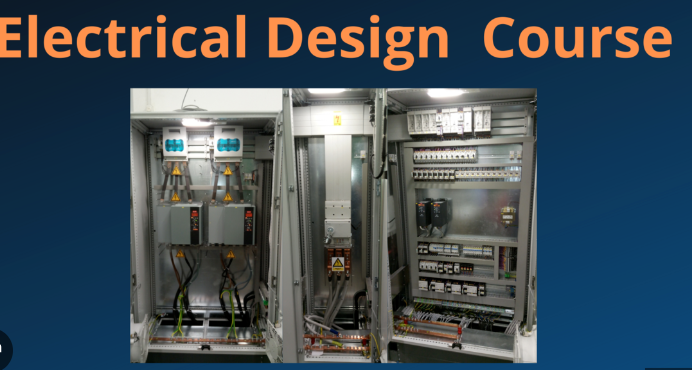In the realm of industrial automation, electrical design plays a pivotal role in ensuring efficient and reliable operation of complex systems. The design process involves careful planning, meticulous analysis, and the integration of various electrical components and systems. This article explores the significance of electrical design in industrial automation, highlighting its key principles, challenges, and benefits.
Understanding Industrial Automation:
Industrial automation refers to the use of control systems, information technologies, and mechanical devices to automate industrial processes. These processes can range from manufacturing and assembly lines to power generation and distribution systems. Electrical design in industrial automation focuses on developing robust electrical infrastructure that enables seamless integration and control of equipment, ensuring optimal performance and productivity.
Key Principles of Electrical Design:
a. System Integration: Electrical design facilitates the integration of diverse components, such as sensors, actuators, controllers, and communication networks, into a cohesive system. Integration enables the exchange of information, real-time monitoring, and effective control over the entire automation process.
b. Safety and Reliability: Industrial automation systems often operate in challenging environments and handle high-power electrical systems. Therefore, electrical design must prioritize safety measures, including proper grounding, circuit protection, and adherence to international standards. Robust design practices ensure the reliability and longevity of the automation system.
c. Scalability and Flexibility: A well-designed electrical system should be scalable to accommodate future expansions or modifications. Flexibility allows for easy integration of new equipment and technologies, reducing downtime during system upgrades or reconfigurations.
Challenges in Electrical Design:
a. Complex System Architecture: Industrial automation systems can be highly complex, with numerous interconnected components. Designers must carefully analyze the system requirements, considering factors such as power distribution, wiring layout, and signal integrity to avoid electrical interference and failures.
b. Electromagnetic Interference (EMI): In industrial settings, electrical devices generate electromagnetic fields that can interfere with sensitive electronic equipment. Effective electrical design incorporates shielding techniques, proper grounding, and signal isolation to mitigate EMI and ensure accurate data acquisition.
c. Environmental Considerations: Industrial environments often expose electrical systems to harsh conditions, including temperature variations, humidity, dust, and vibrations. Electrical design must account for these environmental factors by selecting appropriate components, enclosures, and protective measures to ensure system performance and longevity.
Benefits of Effective Electrical Design:
a. Enhanced Efficiency: Well-designed electrical systems optimize power distribution, minimize energy losses, and reduce downtime. Efficient electrical design contributes to improved productivity, reduced operating costs, and increased overall equipment effectiveness (OEE).
b. Improved Safety: Proper electrical design ensures compliance with safety regulations, minimizing the risk of electrical hazards, shocks, and fires. Safety measures such as emergency shutdown systems, fault detection, and fail-safe designs protect personnel and equipment.
c. Fault Detection and Diagnostics: Effective electrical design incorporates monitoring and diagnostic capabilities, enabling early detection of faults or malfunctions. This facilitates proactive maintenance, minimizes downtime, and enhances system availability.
d. Scalability and Future-Proofing: Thoughtful electrical design allows for system scalability, accommodating future expansions or technological advancements. Future-proofing the design reduces the need for major overhauls, saving time and costs during system upgrades.
Description :
If you are considering a career as an electrical design engineer, then this course is the ideal starting point. Throughout this course, we will delve into two primary areas of focus:
- Industrial refrigeration system:
- Understand the project's objectives, customer requirements, and key features.
- Gain insights into my experience designing industrial automation systems of this nature.
- Access visual documentation of the cabinets, including:
- The main power infeed cabinet equipped with E-Cu busbars measuring 50x10mm and a main circuit breaker.
- The Danfoss softstarters cabinet responsible for driving 160kW and 132kW screw type compressors.
- The technology cabinet with an approximate power consumption of 100kW.
- The PLC cabinet housing a Siemens S7-1500.
- Essential software and its key features:
- Learn about the software tools I rely on daily to design electrical systems for such applications.
- Simaris Design: A power calculation software that assists in dimensioning protection devices, cables, and other components.
- Rittal Therm: Software used to calculate heat loss and determine the appropriate climate control system for enclosures, including fans and air conditioning.
- Eplan Electric P8: This professional engineering software facilitates the creation of comprehensive circuit diagrams.
By enrolling in this course, you will equip yourself with the knowledge and skills necessary to thrive as an electrical design engineer in the field of industrial refrigeration systems.
Conclusion:
Electrical design is an indispensable aspect of industrial automation, providing the foundation for efficient and reliable operation. By considering key principles, overcoming challenges, and harnessing the benefits, designers can create electrical systems that optimize productivity, safety, and adaptability. As industries continue to embrace automation, investing in robust electrical design is crucial for achieving sustainable growth and maintaining a competitive edge in the modern industrial landscape.

